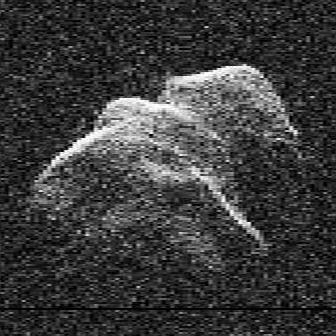
Potentially hazardous object
A potentially hazardous object (PHO) is a near-Earth object – either an asteroid or a comet – with an orbit that can make close approaches to the Earth and which is large enough to cause significant regional damage in the event of impact.[1] They are conventionally defined as having a minimum orbit intersection distance with Earth of less than 0.05 astronomical units (19.5 lunar distances) and an absolute magnitude of 22 or brighter, the latter of which roughly corresponds to a size larger than 140 meters.[2] More than 99% of the known potentially hazardous objects are no impact threat over the next 100 years.[3] As of September 2022, just 17 of the known potentially hazardous objects listed on the Sentry Risk Table could not be excluded as potential threats over the next hundred years.[4] Over hundreds if not thousands of years though, the orbits of some "potentially hazardous" asteroids can evolve to live up to their namesake.
Most of these objects are potentially hazardous asteroids (PHAs), and a few are comets. As of November 2022 there are 2,304 known PHAs (about 8% of the total near-Earth population), of which 153 are estimated to be larger than one kilometer in diameter (see list of largest PHAs below).[5][6][a] Most of the discovered PHAs are Apollo asteroids (1,965) and fewer belong to the group of Aten asteroids (185).[7][8]
A potentially hazardous object can be known not to be a threat to Earth for the next 100 years or more, if its orbit is reasonably well determined. Potentially hazardous asteroids with some threat of impacting Earth in the next 100 years are listed on the Sentry Risk Table. As of September 2022, only 17 potentially hazardous asteroids are listed on the Sentry Risk Table.[4] Most potentially hazardous asteroids are ruled out as hazardous to at least several hundreds of years when their competing best orbit models are sufficiently constrained, but recent discoveries whose orbital constraints are little-known have divergent or incomplete mechanical models until observation yields further data. After several astronomical surveys, the number of known PHAs has increased tenfold since the end of the 1990s (see bar charts below).[5] The Minor Planet Center's website List of the Potentially Hazardous Asteroids also publishes detailed information for these objects.[9]
In May 2021, NASA astronomers reported that 5 to 10 years of preparation may be needed to avoid a potential impactor, as most recently based on a simulated exercise conducted by the 2021 Planetary Defense Conference.[10][11][12]
